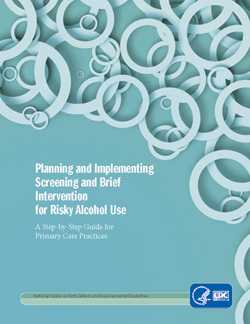CDC’s Alcohol Screening and Brief Intervention Efforts
CDC is working to make alcohol screening and brief intervention (SBI) a routine element of health care in all primary care settings to identify and help people who drink too much.
AJPM Supplement: Cancer Prevention During Early Adulthood

Reduce Risky Alcohol Use

Most adults who drink at risky levels and were asked about their alcohol use during checkups were not advised to drink less.
Alcohol SBI Resources

This guide provides a process and resources to help staff in any primary care practice to plan and implement alcohol screening and brief intervention (SBI).
Why Is Alcohol SBI Important?
Risky Alcohol Use* is Common
29% of U.S. Adults Drink Too Much—Risky drinkers include both the 4% of U.S. adults who are dependent on alcohol (alcoholic) and the 25% who are not dependent. Both groups drink in ways that put themselves and others at risk of harm.1,2
Many Binge Drink†—More than 38 million American adults binge drink, and on average they do it 4 times a month and drink 8 drinks per occasion.3 Binge drinkers may not have experienced harm yet or have harmed others, but harm is more likely if they continue.
Risky Alcohol Use Leads to Widespread Harm
Health & Social Harm—Risky alcohol use contributes to a wide range of negative health and social consequences, including motor vehicle crashes, intimate partner violence, fetal alcohol spectrum disorders (FASDs), and, over time, can result in serious medical conditions, such as hypertension, gastritis, liver disease and various cancers.
Costly & Fatal—Risky alcohol use cost the United States about $249 billion in 20104 and accounts for an estimated 88,000 deaths every year from 2006 to 2010.5
Women & Alcohol—Non-pregnant women of reproductive age who drink at risky levels have an increased chance of experiencing intimate partner violence, alcohol-exposed pregnancy, and unintended pregnancy. If they become pregnant, their drinking may cause harm to their unborn child resulting in miscarriage, stillbirth6 and a range of physical, behavioral and learning problems called FASDs.7
Effective Clinical Interventions Available
Alcohol SBI Works—Over thirty years of research has shown that alcohol screening and brief intervention (SBI) is effective at reducing risky drinking. Based on this evidence, the U.S. Preventive Services Task Force8 and many other organizations have recommended that alcohol SBI be implemented for all adults in primary health care settings. The Community Preventive Services Task Force recently recommended the use of electronic alcohol SBI (eSBI).9
How It Works—Alcohol SBI is a preventive service like hypertension or cholesterol screening that can occur as part of a patient’s wellness visit. It identifies and helps individuals who are drinking too much. Alcohol SBI involves:
- A validated set of screening questions to identify patients’ drinking patterns that only takes a few minutes
- A short conversation with patients who are drinking too much, and referral to treatment as appropriate
CHOICES Works for Women of Reproductive Age—This extended intervention aims to reduce the risk of an alcohol-exposed pregnancy among non-pregnant women who are drinking at risky levels and not using contraception effectively or consistently. CHOICES helps women reduce risky alcohol use, increase contraceptive use, or change both behaviors.
Yet What Works Isn’t Used—CDC believes that alcohol SBI and CHOICES could reduce the consequences of risky alcohol use and its related harms if they became standards of care. Despite their efficacy, however, they have not been broadly adopted or integrated into clinical settings.
Preventing Fetal Alcohol Spectrum Disorders
Broadening CDC’s FASD prevention efforts to include both alcohol SBI and CHOICES provides the opportunity to offer both brief and extended intervention options to women of reproductive age as appropriate, and to address risky alcohol use within the broader context of women’s health.
Women report that the drinking behavior of their partner, family members, and friends are strong influences on their alcohol consumption.
Providing alcohol SBI to all individuals— men, women, and adolescents—might normalize discussion of alcohol use and begin to reduce the stigma associated with getting help.
About CDC’s Alcohol SBI Activities
CDC’s alcohol SBI initiative includes efforts to support alcohol SBI implementation in medical and other settings, improve tracking of alcohol SBI implementation, and identify and partner with healthcare providers, health systems, and insurers to develop and implement system-level strategies that foster implementation of alcohol SBI and CHOICES.
Putting Alcohol SBI into Practice
CDC develops and promotes
- Alcohol SBI Implementation Guide—This guide provides a process and resources to help staff in any primary care practice to plan and implement alcohol screening and brief intervention (SBI) to reduce alcohol use, an evidence-based approach recommended for all adults, including pregnant women. The guide also presents information on risky alcohol use and how it can be addressed through alcohol SBI.
- Alcohol SBI Guide and Website—These resources, developed by the American College of Obstetricians and Gynecologists, can be used in OB/GYN settings.
- Pediatric SBI Implementation Guide—The American Academy of Pediatrics (AAP) has developed this guide to help pediatricians incorporate screening, brief intervention, and referral to treatment for use of alcohol, tobacco, marijuana, and other drugs among adolescent patients.
- CHOICES Intervention Materials—These tools help behavioral health counselors conduct the CHOICES intervention: includes a counselor manual, client workbook, and training of trainers guide.
CDC funds and supports
- Collaborative for Alcohol-Free Pregnancy: Partnering for Practice Change—CDC works with FASD Practice and Implementation Centers and National Partners to improve healthcare practice, education, and awareness among healthcare professionals through the use of evidence-based practices, such as alcohol screening and brief intervention (SBI) to prevent alcohol-exposed pregnancy and risky alcohol use.
- CHOICES and alcohol SBI in American Indian Communities—CDC funds two organizations to provide training and technical assistance on alcohol SBI and CHOICES implementation to clinics serving American Indian populations.
Improving Data Systems for Tracking
- Quality Improvement Measures—CDC is monitoring the development of quality improvement measures for alcohol SBI in multiple systems: the Healthcare Effectiveness Data and Information Set (HEDIS) measures, National Quality Forum-endorsed measures, and Meaningful Use standards endorsed by the Centers for Medicare and Medicaid Services (CMS). If implemented, these measures should have an important impact on provider uptake of alcohol SBI.
- New Data—It is not possible to assess the impact of alcohol SBI because no surveillance datasets currently measure uptake by medical practices. CDC is seeking to better understand provider behaviors by:
- Adding questions about alcohol SBI to existing national surveys such as the Behavioral Risk Factor Surveillance System, and the National Ambulatory Medical Care Survey.
- Utilizing health marketing surveys to obtain data on provider behaviors (e.g., ConsumerStyles, DocStyles).

Strengthening Partnerships to Improve System-level Strategies
- CDC is developing partnerships with the private sector—e.g., insurers and health systems—to promote uptake of alcohol SBI in primary care settings.
- CDC is collaborating with medical and non-profit groups and other federal agencies to inform strategies that impede or support implementation of alcohol SBI in primary care settings.
Future Activities
- CDC will share best practices and tools regarding implementation of alcohol SBI and CHOICES in primary care settings.
- CDC will identify opportunities to work with private sector partners to explore their role in increasing the use of alcohol SBI to reduce risky drinking.
*Risky alcohol use is also referred to as alcohol misuse, or excessive, unhealthy, hazardous, or harmful drinking.
†Binge drinking is defined as having 4 or more drinks at one time for females; 5 or more drinks at one time for males.
References
- Grant BF, Dawson DA, Stinson FA, et al. The 12-month prevalence and trends in DSM-IV alcohol abuse and dependence: United States, 1991-1992 and 2001-2002. Drug Alcohol Depend. 2004;74:223-234. PMID: 15194200
- Dawson DA, Grant BF, Stinson FS, et al. Toward the attainment of low-risk drinking goals: A 10-year progress report. Alcohol Clin Exp Res 2004;28:1371-1378. PMID: 15365308
- Centers for Disease Control and Prevention (CDC). Vital signs: Binge drinking prevalence, frequency, and intensity among adults— United States, 2010. MMWR Morb Mortal Wkly Rep. 2012;61:14-19. PMID: 22237031
- Sacks JJ, Gonzales KR, Bouchery EE, Tomedi LE, Brewer RD. 2010 National and state costs of excessive alcohol consumption. Am J Prev Med 2015;49:e73–e79.
- Stahre M, Roeber J, Kanny D, Brewer RD, Zhang X. Contribution of excessive alcohol consumption to deaths and years of potential life lost in the United States. Prev Chronic Dis 2014;11:E109.
- Bailey BA, Sokol RJ. Prenatal alcohol exposure and miscarriage, stillbirth, preterm delivery, and sudden infant death syndrome. Alcohol Res Health. 2011;34(1):86-91. PMID: 23580045
- Riley EP, McGee CL. Fetal alcohol spectrum disorders: an overview with emphasis on changes in brain and behaviour. Exp Biol Med. 2005;230:357-365. PMID: 15956765
- Jonas DE, Garbutt JC, Amick HR, et.al. Behavioral counseling after screening for alcohol misuse in primary care: a systematic review and meta-analysis for the U.S. Preventive Services Task Force. Ann Intern Med. 2012;157(9):645-654. PMID: 23007881
- Tansil KA, Esser MB, Sandhu P, et al. Alcohol electronic screening and brief intervention: A Community Guide systematic review. Am J Prev Med 2016;51(5):801-11.
- Page last reviewed: August 14, 2017
- Page last updated: August 14, 2017
- Content source:



 ShareCompartir
ShareCompartir